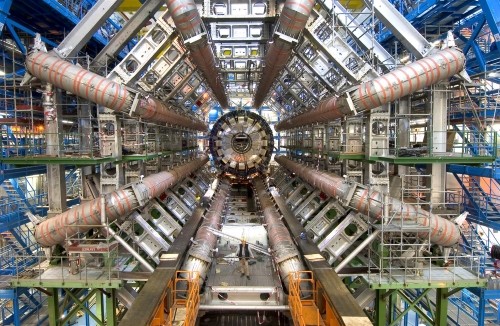
ATLAS under construction: has the experiment gone beyond the Standard Model? (Courtesy: ATLAS)
By Hamish Johnston
Excitement levels in the world of particle physics hit the roof this week as further evidence emerged that physicists working on the Large Hadron Collider (LHC) may have caught sight of a new particle that is not described by the Standard Model of particle physics. If this turns out to be true, it will be the most profound discovery in particle physics in decades and would surely lead to a Nobel prize.
In December 2015 I wrote about a curious bump that appears in data from the ATLAS and CMS experiments on the LHC. The bump appears at about 750 GeV and could be indicative of the existence of a brand new boson with a mass of 750 GeV/c2. In December were told that ATLAS had spotted the bump with a statistical significance of 3.6σ – much lower than the 5σ required for a discovery in particle physics.
Now, the ATLAS team has performed a different analysis of its data and again found the bump with a similar significance. This suggests that the first analysis was not some sort of fluke. Furthermore, physicists working on the CMS experiment on the LHC have announced that they have spotted the bump with a significance of 3.4σ, up from their previous value of 2.6σ.
These announcements were made yesterday at the 51st Rencontres de Moriond conference, where rumours were flying that an alternative (but as yet unreleased) analysis by ATLAS puts the significance up to 4.7σ. As ever, there is excellent in-depth analysis of the bump on the Résonaances blog: “Diphoton update”.
“Heat rises” is something that everyone learns in school. This simple fact plays a crucial role in how fires spread here on Earth. Flames and smoke flow upwards, while oxygen-rich air is pulled in from below. But what if you take away gravity? Would the smoke just hang around the flame, preventing fresh oxygen from stoking the fire? Engineers at NASA’s Glenn Research Center in Cleveland, Ohio, are trying to answer these questions by burning things in space. The first of three experiments will launch on 22 March and will involve burning a large sample of material that is typically used in space missions.
Neil Turok is one of the most eloquent physicists I know, especially when it comes to explaining very complicated ideas. In a programme recorded for Canada’s CBC Radio, the director of the Perimeter Institute for Theoretical Physics tells journalist Paul Kennedy why he believes the future is bright for physicists. Given the recent excitement at CERN, I couldn’t agree more.
1. The 750 GeV bump seen by both the LHC detectors, is still quite a bit in the rumour world. More data should clarify the horizon.
2. Prof. Neil Turok as the director of the PI is indeed eloquent, but a bit in a noisy manner!
More from interview.
“So I think that sort of theoretical catastrophe, as I view it — meaning the logical pursuit of quantum mechanics and relativity over a hundred years was tremendously successful at some level but finding its own successor theory, it hasn’t been successful. I think that is also laying the ground for some sort of revolutionary change in the sense that we basically will have to go back to the founding principles. It looks like the founding principles of modern physics — quantum theory and relativity — have played out and they have not given us the answers we need. And so we have to go back and question those founding principles and find whatever it is, whatever new principle will replace them. So matching these great puzzles posed by the observations are equally great puzzles in our fundamental theories. And so that is just a wonderful thing to contemplate in itself.”
The big experimental observations, specially in the domain of cosmology, are cumulating raising the mental tension for the needed break through.
Interesting, very nice thoughtful reflection from RLO.
The only useful consequence of bringing relativity and quantum theory together would be a good explanation of the ultimate physical explanation of gravitation. That explanation might not show or is likely not to reveal the existence of the graviton, for gravitation has to be a pseudoforce. This is clear to me and has a good scientific reason behind. However I think that physics does have a new future but not due to the discovery of new sensational particles except perhaps one for neclear decay. Otherwise the universe can be fully materially explained by the Standard Model as it is. There is even no reason why we should have a new force. Since gravity is neutral, it cannot exist as plus and minus particles. Antigravity requires a new kind of matter and it has to be neutral, if it exists, as gravity.
The most enigmatic part of the Standard Model is flavor physics. Just here may be the future breakthrough.
Trackback: Blog - physicsworld.com